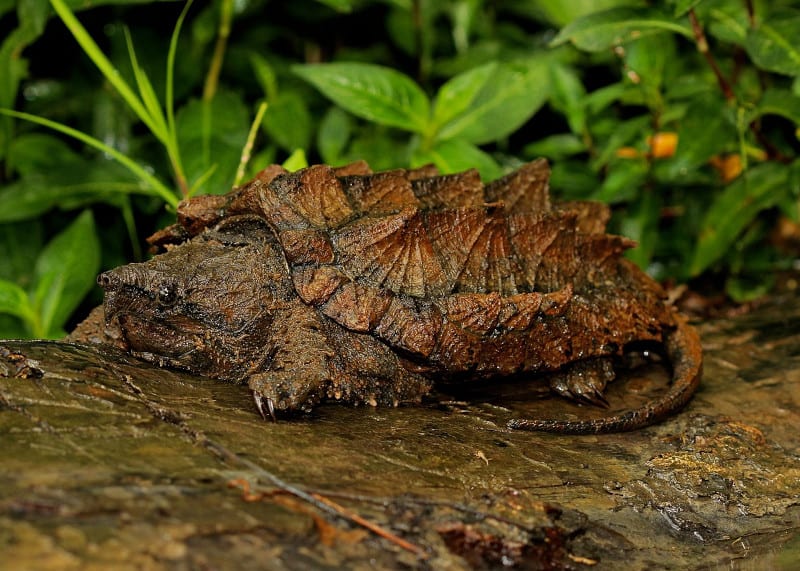
Alligator Snapping Turtle Facts
- This visually astonishing product of natural evolution most frequently goes by the descriptive and informative common name of the Alligator Snapping Turtle. For the moment, it has no other widely accepted general name. But then, this one says it all.
- Among herpetologists, though, it’s typically referred to by its formal moniker. That, like so many others, however, is hard for the layperson to pronounce. That’s because this wonder of Nature bears the technical title of Macrochelys temminckii.
- The animal received this title due to the efforts of the respected Dutch-American naturalist, Gerardus Troost. He accomplished the first formal recognition of it as a separate and distinct species. This scientifically noteworthy action occurred in 1835.
- Regardless of which name one chooses to use, it’s an extraordinary creature. It represents the largest known variety of freshwater turtle on the continent it appears on. Though not a close relative, it’s often associated with the common snapping turtle.
- Sadly, the population of this marvel continues to decline. This unfortunate situation also seem to hold true throughout the entirey of its native range. Due to this trend, the IUCN presently lists the remarkable reptile as Vulnerable on its published Red List.
- The Alligator Snapping Turtle faces multiple threats to its existence. It’s hunted for its flesh, and is also popular in the exotic pet trade. Habitat loss due to human expansion, also endangers it. It also now finds itself facing the danger of climate change.
Related Articles
CCL: https://bit.ly/3KnJOGf
Alligator Snapping Turtle Physical Description
The amazing Alligator Snapping Turtle immediately captures the attention of those who encounter it. Not surprisingly, though, it does so for several reasons. Its pure appearance obviously startles most people. Yet it also impresses one with its sheer physical size.
Like many reptiles, it also displays a certain degree of the physiological trait of sexual dimorphism. In its case, however, this characteristic manifests itself in terms of length and mass. It also does so to a relatively great degree. Males attain much greater measurements.
Fully mature adults average a carapace length ranging from 13. 8 – 31.8 in (35 – 80.8 cm). Males tend to be on the higher end of that range, while females typically hold down the lower end. Exceptional individuals of both genders do sometimes occur, of course.
Average weights also vary widely, in keeping with this pattern. Females average closer to 19 lb (8.4 kg). Their male counterparts, meanwhile, average 176 lb (80 kg). An unconfirmed male specimen, though, reportedly achieved an astounding weight totaling 403 lb (183 kg)!
The heaviest confirmed example, a male, weighed 249 lb (113 kg). Except for the size difference, the two sexes appear nearly indistiguishable. They’re known for the three ridges of large scales on the thick shells. This shows a mix of gray, brown, black, or olive green.
Yet the remarkable Alligator Snapping Turtle evolved even more intriguing physical adaptations. The large, heavy head has a sharp beak. Even the inside of the mouth is camouflaged. Used to lure fish, a worm-like appendage appears on the tip of the tongue.
- Kingdom: Animalia
- Phylum: Chordata
- Class: Reptilia
- Order: Testudines
- Family: Chelydridae
- Genus: Macrochelys
- Species: M. temminckii
Alligator Snapping Turtle Distribution, Habitat, and Ecology
The attention-grabbing Alligator Snapping Turtle evolved as native to a moderately limited region of the world. The precise location of that swathe of the globe, however, might surprise some people. That’s because it developed as endemic to a portion of North America.
There, its zone of habitation falls within the confines of the United States. Even there, though, it only appears natively in the southeastern regions of the country. That range extends from Florida west to Texas. From Louisiana that extends north as far as Indiana.
The vast majority of specimens, live in the more southern parts of that range, though. Yet, in all areas it lives in, the animal displays extreme preferences in its choice of habitat. The reptile is typically only found in bodies of water that flow into the Gulf of Mexico.
This does include several types of smaller ecosystems, however. That includes areas of creeks, lakes, marshes, canals, and slow-moving rivers. The creature also prefers the presence of beaver dens, submerged dead trees, shrubs, and low-hanging trees.
Not surprisingly, the Alligator Snapping Turtle evolved as a carnivore. It’s also a highly opportunistic feeder. It both actively hunts for prey, and scavenges dead organisms. As a general principle, this powerful creature consumes virtually anything it can catch.
The main components of its diet consist of fish, amphibians, mollusks, and carrion. But it’s also known to consume snail, snakes, worms, insects, and crawfish. It even consumes the occasional plant. Larger individuals even eat such prey as birds, squirrels, and opossums!
Species Sharing Its Range
Check out our other articles 7 Gorgeous Invertebrates of Georgia, Scalloped Hammerhead, Villarrica, Island Fox, Jelly Ear, Southern Darwin’s Frog, Shoebill, Texas Alligator Lizard
